As we turn the calendar to March, I thought I would turn to a new series of posts in my Professional Wednesday feature. This month, as I struggle with a bit of work-related inertia, I have decided some might find it helpful to read about “What Holds Me Back.” Because let’s be honest — those of us who seek to make a living as professional creators face no shortage of obstacles to productivity. We have to be self-motivated, we have to be disciplined, we have to be imaginative and prolific on demand. None of this is easy and at times it seems hobgoblins lurk in every corner, threatening to undermine even the most sincere determination to get stuff done.
What — or who — are my hobgoblins? How do they disrupt my work patterns, and what do I do to keep them at bay? These are the questions I hope to address in the next several Wednesday posts.
This week, I address perhaps the most obvious and formidable hobgoblin of them all: Life.
Life is a fickle bastard, with a cruel streak a mile wide, a perverse — at times evil — sense of humor, and a preternatural knack for intruding at the absolute worst moment. But Life can also be charming, deeply attractive, kind, generous, and downright fun. This is part of what makes Life such a difficult opponent in the battle over productivity. Life is as changeable as March weather, as unpredictable as the best storyline, and as relentless as time itself. Life happens constantly; Life will not sit quietly in a corner reading a book and respecting our need for calm just because we have a looming deadline or a new idea we are eager to explore. Life lives to mess with us.
All strange metaphors aside, in my experience, relating to my own work output and also my interactions with other professionals, general life disruptions are responsible for the vast majority of missed deadlines and punted obligations. Sometimes it’s the (relatively) small stuff — a kid with a bad cold or stomach bug, a blown car engine or flat tire, a flooded basement or loss of power. Sometimes it’s more serious than that — an ailing elderly parent, a dire illness in the family, a failing marriage, the death of a friend or relative. I’ve faced my share of such things — not all, but enough; every one of us has.
And in the short term, there is nothing we can do about them. Life imposes its own exigencies. When our kid is sick or our parents are fading or a relative or friend is in need, we have no choice but to prioritize the people we love and the obligations we’ve taken on as parents and partners, offspring and siblings and friends. No one with a thread of compassion or decency should punish or blame us for this. Those who would, do so at their own risk, because eventually they, too, will be on the receiving end of Life’s caprice.
The problem comes later, after the crisis has passed, but while the aftermath lingers. Nearly two years ago, when our daughter received her cancer diagnosis, I withdrew from . . . well, pretty much everything. I told my agent and editor that I wouldn’t be able to make a deadline that was still a couple of months away. I stopped seeing friends. I hunkered down with my fear and my grief and my anger, and I essentially surrendered to this terrible thing Life had done to my family and me. I was sure I couldn’t work through it, and so I didn’t even think it worthwhile to make the attempt.
Nancy responded differently, not because she is better or stronger than I am (although she might well be both . . .) but because she deals with emotional strain differently. She is great at compartmentalizing, which is good, because at the time she had a high-stress, high-profile job. In the time since, she has advanced to a position that is even more high-stress and high-profile. Her ability to compartmentalize has served her well.
I don’t have that ability. I can’t compartmentalize. But, I realized, I had a different ability I could harness. I had learned years ago — when we lost my parents, and later when we lost my eldest brother — to channel my grief and pain into my art. And it didn’t take me long after hearing the news of our daughter’s illness to understand that was precisely what I needed to do. Within a week of calling my agent and editor to tell them I was pulling back, I sent them new messages. I am working through this. I will make my deadline.
 And I did. The book was Invasives, by the way. It contains the best character work I’ve ever done, and that is no coincidence.
And I did. The book was Invasives, by the way. It contains the best character work I’ve ever done, and that is no coincidence.
I suffer from anxiety and panic disorder. I sometimes walk the edge of depression. I know as well as anyone that coping with life is hard, and that glib, easy-fix solutions to the shit life throws at us are worse than useless. Such facile responses can actually hurt, because they suggest to those of us who struggle that the problem isn’t the circumstance but rather our inability to deal with it.
But I know as well, from my own experience, that we don’t have to be whole to create. Life elicits emotion and those emotions can overwhelm and paralyze. The thing is, though, we’re creators, and emotion is our bread and butter. Yes, at times the emotions we feel in life’s rawest moments are like a downed electrical wire. We touch them at our own risk. As I found a couple of years ago, however, we can be resilient in the face of the worst circumstances. Long before I was ready to interact with other people, I was ready, even eager, to take hold of that live wire and use it for something constructive and healing.
Life can disrupt our art. We all know this. But we are alchemists at heart. We can turn grief and hurt and fear and anger into golden moments on the page (or the canvas or the guitar or the stage — whatever). And, for me at least, that is how I keep life from holding me back.
Keep writing.









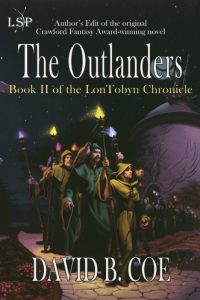 For the past several weeks, I have been sharing “My Best Mistakes,” which have included
For the past several weeks, I have been sharing “My Best Mistakes,” which have included 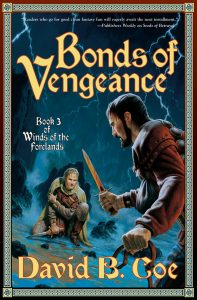 My first series, the LonTobyn Chronicle, did well. It won the Crawford Award as the best fantasy by a new author, and my sales grew steadily. Children of Amarid would eventually go through six printings. When I signed contracts for my second series of novels, Winds of the Forelands, Tor gave me significantly higher per-book advances.
My first series, the LonTobyn Chronicle, did well. It won the Crawford Award as the best fantasy by a new author, and my sales grew steadily. Children of Amarid would eventually go through six printings. When I signed contracts for my second series of novels, Winds of the Forelands, Tor gave me significantly higher per-book advances. Right around the holidays, I was shouting from the virtual rooftops about my new Celtic urban fantasy trilogy, The Chalice War, which would be coming out early in 2023. The first book, I bellowed (virtually), would be coming out in February, and it would be called The Chalice War: Stone. It would be followed, a month or so later, by The Chalice War: Cauldron, and then a couple of months after that by the finale, The Chalice War: Sword.
Right around the holidays, I was shouting from the virtual rooftops about my new Celtic urban fantasy trilogy, The Chalice War, which would be coming out early in 2023. The first book, I bellowed (virtually), would be coming out in February, and it would be called The Chalice War: Stone. It would be followed, a month or so later, by The Chalice War: Cauldron, and then a couple of months after that by the finale, The Chalice War: Sword.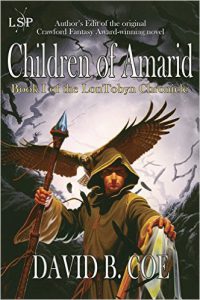 Very early in my career, when my first book, Children of Amarid, was the only one I had out, I responded publicly to a online review from a less-than-delighted reader. Amazon was still a novelty (no pun intended) as was the notion of online reader reviews. (Hard to imagine, right? That the idea of readers offering reviews of the books they’d read should have been new and different and even a bit odd?) I don’t remember what the reader in question objected to about the book, nor do I remember what I said in my public response. The original book is out of print now — only the 2016 reissues are available on the site, so our exchange is lost to the ages. All I know is that someone criticized the book, I didn’t take the criticism well, and I took it upon myself to write a reply and post it to the Children of Amarid Amazon page.
Very early in my career, when my first book, Children of Amarid, was the only one I had out, I responded publicly to a online review from a less-than-delighted reader. Amazon was still a novelty (no pun intended) as was the notion of online reader reviews. (Hard to imagine, right? That the idea of readers offering reviews of the books they’d read should have been new and different and even a bit odd?) I don’t remember what the reader in question objected to about the book, nor do I remember what I said in my public response. The original book is out of print now — only the 2016 reissues are available on the site, so our exchange is lost to the ages. All I know is that someone criticized the book, I didn’t take the criticism well, and I took it upon myself to write a reply and post it to the Children of Amarid Amazon page.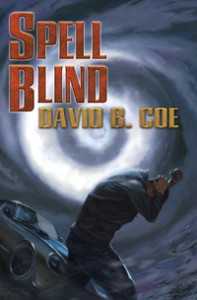 Some years later, soon after the release of Spell Blind, the first book in The Case Files of Justis Fearsson, another Amazon reviewer panned the book because my book was “a blatant rip-off” of Jim Butcher’s Harry Dresden books, “a ludicrous case of copycatting.” For the record, I didn’t copy Dresden at all. I had only read the first two books of the series, and the “copycatting” the reviewer claimed I’d done amounted to using tropes of the genre, not elements of Butcher’s work. And so I responded to the review, wanting to set the record straight.
Some years later, soon after the release of Spell Blind, the first book in The Case Files of Justis Fearsson, another Amazon reviewer panned the book because my book was “a blatant rip-off” of Jim Butcher’s Harry Dresden books, “a ludicrous case of copycatting.” For the record, I didn’t copy Dresden at all. I had only read the first two books of the series, and the “copycatting” the reviewer claimed I’d done amounted to using tropes of the genre, not elements of Butcher’s work. And so I responded to the review, wanting to set the record straight.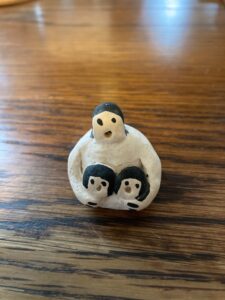 During our tour, we encountered many people selling pottery in front of their homes. And at one table, a mother displayed her wares beside those of her young daughter. I think the girl must have been around 7 or 8, give or take a year, and she had made a few small bowls, seed pots, and dishes. And she had made a tiny storyteller. As one would expect, it was quite crude compared to those we had seen for sale back in Albuquerque (we hadn’t yet been to Santa Fe or Taos), but something about the figure spoke to me. Maybe is was just that the storyteller was so cute. Or maybe it was that the girl herself was so proud of it. Or maybe I saw in this child’s early effort to follow in her mother’s footsteps something akin to my dream of becoming a professional writer. Whatever the reason, I asked the girl how much it cost.
During our tour, we encountered many people selling pottery in front of their homes. And at one table, a mother displayed her wares beside those of her young daughter. I think the girl must have been around 7 or 8, give or take a year, and she had made a few small bowls, seed pots, and dishes. And she had made a tiny storyteller. As one would expect, it was quite crude compared to those we had seen for sale back in Albuquerque (we hadn’t yet been to Santa Fe or Taos), but something about the figure spoke to me. Maybe is was just that the storyteller was so cute. Or maybe it was that the girl herself was so proud of it. Or maybe I saw in this child’s early effort to follow in her mother’s footsteps something akin to my dream of becoming a professional writer. Whatever the reason, I asked the girl how much it cost.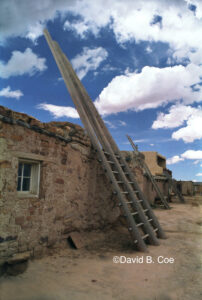 That was a magical day in many ways. Acoma was as beautiful as we had been told, the pale red stone of the Pueblo seeming to glow beneath a deep azure sky, wooden kiva ladders rising above their structures and reaching toward the clouds. At one point, I spotted a rainbow in the clouds overhead — there was no rain, just the prismatic color, which appeared for a moment and then vanished. I think I was the only one on the tour who saw it. I believed that, together, the rainbow and my little storyteller were omens, signs that my dream would, in fact, come to pass.
That was a magical day in many ways. Acoma was as beautiful as we had been told, the pale red stone of the Pueblo seeming to glow beneath a deep azure sky, wooden kiva ladders rising above their structures and reaching toward the clouds. At one point, I spotted a rainbow in the clouds overhead — there was no rain, just the prismatic color, which appeared for a moment and then vanished. I think I was the only one on the tour who saw it. I believed that, together, the rainbow and my little storyteller were omens, signs that my dream would, in fact, come to pass. My “What matters?” series of posts will conclude next Monday, after a Monday Musings post this week that straddled the personal and professional a bit more than usual. In the meantime, I am using today’s Professional Wednesday post to begin pivoting toward the impending release of my new series, a contemporary urban fantasy that delves deeply into Celtic mythology. The series is called The Chalice War, and the first book is The Chalice War: Stone. It will be released within the next month or so, and will be followed soon after by the second book, The Chalice War: Cauldron, and the finale, The Chalice War: Sword.
My “What matters?” series of posts will conclude next Monday, after a Monday Musings post this week that straddled the personal and professional a bit more than usual. In the meantime, I am using today’s Professional Wednesday post to begin pivoting toward the impending release of my new series, a contemporary urban fantasy that delves deeply into Celtic mythology. The series is called The Chalice War, and the first book is The Chalice War: Stone. It will be released within the next month or so, and will be followed soon after by the second book, The Chalice War: Cauldron, and the finale, The Chalice War: Sword.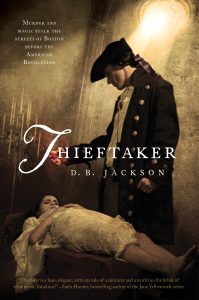 I finished the book and showed it to my agent. She liked it a lot, but thought it needed work. She was right, of course. But by that time, I had signed the contracts for Robin Hood and the Thieftaker books. Not too long after, I finally sold the Fearsson series to Baen Books and so had that trilogy to get through.
I finished the book and showed it to my agent. She liked it a lot, but thought it needed work. She was right, of course. But by that time, I had signed the contracts for Robin Hood and the Thieftaker books. Not too long after, I finally sold the Fearsson series to Baen Books and so had that trilogy to get through.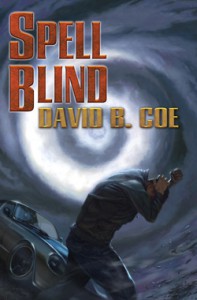 But I never forgot my Celtic urban fantasy, or its heroes Marti and Kel. When I had some spare time, I went back and rewrote the book, incorporating revision notes from friends and from my agent with my own sense of what the book needed. I rewrote it a second time a couple of years later, and having some time, started work on a second volume, this one set in Australia (where my family and I lived in 2005-2006). I stalled out on that book about two-thirds of the way in, but I liked what I had. By then, though, I was deeply involved with the final Thieftaker books and the Fearsson series. And I was starting to have some ideas for what would become the Islevale trilogy.
But I never forgot my Celtic urban fantasy, or its heroes Marti and Kel. When I had some spare time, I went back and rewrote the book, incorporating revision notes from friends and from my agent with my own sense of what the book needed. I rewrote it a second time a couple of years later, and having some time, started work on a second volume, this one set in Australia (where my family and I lived in 2005-2006). I stalled out on that book about two-thirds of the way in, but I liked what I had. By then, though, I was deeply involved with the final Thieftaker books and the Fearsson series. And I was starting to have some ideas for what would become the Islevale trilogy.